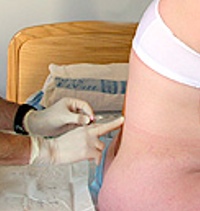 First let me start of my saying that my intent with this post is to inform. Not to make anyone defensive or feel guilty about their decisions. I think many women accept an epidural without being aware of the risks that epidurals carry.
First let me start of my saying that my intent with this post is to inform. Not to make anyone defensive or feel guilty about their decisions. I think many women accept an epidural without being aware of the risks that epidurals carry.
Epidurals can and do lead to:
– higher c-section rates
– hypotension (significantly low blood pressure)
– fetal distress
– IV Cannulation (this is when the anesthesia enters the blood stream, and can lead to convulsions, twitching and even seizures)
– Trauma to blood vessels or punctured dura (this occurs if the neddle is misplaced and goes through the walls of the spinal colomn resulting in bleeding and/or headaches)
– Infection
– Backache (This is one of the most common complications of an epidural)
– Abnormal uterine contractions (Epidurals tend to slow down labour and as a result synthetic oxytocen will be given to strengthen the dwindling contractions. Synthetic oxytocen carries it own risks, such as dangerously high blood pressure, abnormal heart rhythms, nausea and vomiting, sustained uterine contractions which last too long and result in the baby going into distress from lack of oxygen.
– Lengthen the duration of the labour, in particular the second stage of labour (pushing or birthing stage) as mother is not aware of what her body is doing and therefore does not assist the process.
– Trouble with breast-feeding (some of the drugs pass into baby’s body and make them less alert and able to breast-feed when they are born)
Another issue with epidurals, as well as any intervention, is that one intervention leads to another and another and another. There is a wisdom in the process of undisturbed birth, but it is very hard within the medical model for care providers to simply sit back and observe. It is much more common for us, in our culture to “do something”. So interventions are aimed at improving the labour and birth. However, each invention carries risks and the more interventions that occur, the more risk is involved for both mom and baby. Now of course, some intervention have their place. However I believe that a woman needs to know and understand the pros and cons for each intervention.
Epidurals are often portrayed by doctors as the magic wand that makes birth wonderful. One my prenatal yoga students recently recounted how her doctor said “why would you want the jalopy, when you could have the royals royce?” in response to her desire for a natural birth. Epidurals have a darker side and it’s important to take ownership of the risks if that is the course that a women wants to take.
I believe that if more women were aware of the risk and possible harm to themselves and their babies they would not be so eagerly lining up to get the epidural.
A Saskatoon doctor who has done a survey of research studies that have been done on epidurals reached this conclusion.
“Women are almost never given informed consent for epidurals. Even if they were just read two paragraphs from the package insert that comes with the medication used for epidurals (manufactured by Abbott Laboratories), they might think twice. The package insert states:
|
Who would sign a consent if it included the above language? The degree to which the facts about the risks of epidural anesthesia are hidden from women in labor is astonishing.
Mothers who have a fever are significantly more likely to have had epidural anesthesia.82 Therefor increasing the incidence of septic workups on newborns and the subsequent complications of this procedure.
We would hope that pregnant women would have a more informed explanation of the risks of epidural anesthesia than what is currently given, and would suspect that many would make other choices if true informed consent was given (before labor, when the woman still has time to prepare to cope with childbirth pain in other ways).” Lewis E. Mehl-Madrona, M.D., Ph.D. , Associate Professor of Family Medicine and Psychiatry, Department of Family Medicine, University of Saskatchewan College of Medicine
( http://www.healing-arts.org/mehl-madrona/mmepidural.htm#medical_risks_epidurals_rates)
Hopefully I have opened you up to the possibility of labour without an epidural. If you are looking for some resources to support you, check out these books. All of which are available at our local library.
Hypnobirthing: the Mongan Method
The Thinking Woman’s Guide to a Better Birth
Marie





One thought on “The Truth about Epidurals”
Thank you posting on A Midwifes Legacy (facebook) lauraeodell.com